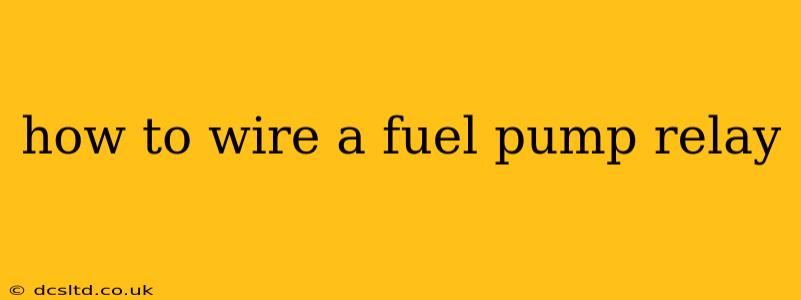A fuel pump relay is a crucial component in your vehicle's fuel system, acting as an electrical switch that controls the power flow to the fuel pump. Understanding how to wire a fuel pump relay is essential for both troubleshooting fuel delivery issues and for installing aftermarket fuel pumps. This guide will walk you through the process, addressing common questions and concerns.
Important Safety Note: Working with automotive electrical systems involves potential hazards. Always disconnect the negative battery terminal before beginning any wiring work. If you are uncomfortable working with electricity, consult a qualified mechanic.
Understanding the Fuel Pump Relay Circuit
Before diving into wiring, it's crucial to grasp the basic circuit. The relay acts as a high-current switch, protecting the vehicle's delicate ignition switch from the high amperage draw of the fuel pump. The circuit generally involves four main components:
- Battery (+): Provides the power source for the fuel pump.
- Ignition Switch (+): Provides the signal to activate the relay.
- Fuel Pump (-): Ground connection for the fuel pump.
- Fuel Pump (+): The power connection to the fuel pump.
Common Fuel Pump Relay Wiring Diagrams
While the basic principles remain the same, the exact wiring configuration can vary depending on the vehicle's make and model. You'll typically find a fuel pump relay in the fuse box, under the hood or inside the vehicle. Consulting your vehicle's repair manual is highly recommended for the specific wiring diagram. However, a generalized diagram often looks like this:
+12V Battery
|
|
+-----+
|Relay|-----+--- Fuel Pump (+)
+-----+ |
| |
| |
Ignition Switch (+)---||--- 85 (Relay Coil)
| |
| |
Ground ---||--- 86 (Relay Coil)
|
|
Ground --- Fuel Pump (-)
Explanation of Relay Terminals (may vary depending on the relay):
- 85 & 86: These are the relay coil terminals. A low current signal from the ignition switch energizes the coil, activating the relay.
- 30: This is the battery power input.
- 87: This is the output to the fuel pump.
How to Wire a Fuel Pump Relay: Step-by-Step Guide (General)
- Locate the Relay: Identify the fuel pump relay in your vehicle's fuse box. The location varies greatly depending on the vehicle.
- Gather Necessary Tools: You will need wire strippers, crimp connectors, a multimeter (for testing), and potentially some additional wire.
- Disconnect the Battery: Always disconnect the negative battery terminal before working with the electrical system.
- Identify Wires: Using a multimeter or your vehicle's wiring diagram, identify the wires connecting to the battery, ignition switch, and the fuel pump.
- Connect to Battery (+): Connect one wire from the battery's positive terminal to terminal 30 on the relay.
- Connect to Ignition Switch (+): Connect the wire from the ignition switch to terminal 85 on the relay.
- Connect Ground (86): Connect a wire from a solid ground point to terminal 86 on the relay.
- Connect to Fuel Pump (+): Connect a wire from terminal 87 on the relay to the positive terminal of your fuel pump.
- Connect Fuel Pump (-): Ensure the negative terminal of your fuel pump is properly grounded.
- Reconnect the Battery: Carefully reconnect the negative battery terminal.
- Test the System: Turn the ignition key to the "ON" position (without starting the engine). You should hear the fuel pump prime briefly. If not, double-check all connections.
Troubleshooting Common Problems
The fuel pump doesn't activate when the ignition is turned on.
- Check the fuses: A blown fuse in the fuel pump circuit will prevent the pump from working.
- Check the relay: Try replacing the fuel pump relay with a known good one.
- Inspect wiring: Look for broken, corroded, or loose connections.
- Test the ignition switch circuit: Use a multimeter to check if the ignition switch is providing the correct signal to the relay.
The fuel pump runs continuously.
- Check the relay: A faulty relay may stay energized, causing the pump to run continuously.
- Check the ignition switch: A faulty ignition switch might not be properly breaking the circuit.
Frequently Asked Questions
What happens if the fuel pump relay fails?
A failed fuel pump relay prevents power from reaching the fuel pump, resulting in a no-start condition. The engine won't run because it has no fuel.
Can I use a universal fuel pump relay?
While universal relays exist, it's crucial to ensure they're rated for the correct amperage. The fuel pump draws a significant current, and an under-rated relay could overheat and fail. Consult your vehicle's specifications.
How do I know if my fuel pump relay is bad?
You can test it with a multimeter by checking the continuity of the coil and the switch contacts. You can also swap the relay with another relay of the same type (if possible) and see if it resolves the problem.
Can I wire a fuel pump directly to the battery?
While possible, wiring the fuel pump directly to the battery is strongly discouraged. It bypasses critical safety features, potentially damaging the vehicle's electrical system and posing a fire hazard.
This guide provides a general overview of wiring a fuel pump relay. Always consult your vehicle's repair manual for specific wiring instructions and diagrams. Remember safety first – if you’re unsure about any step, consult a qualified mechanic.
